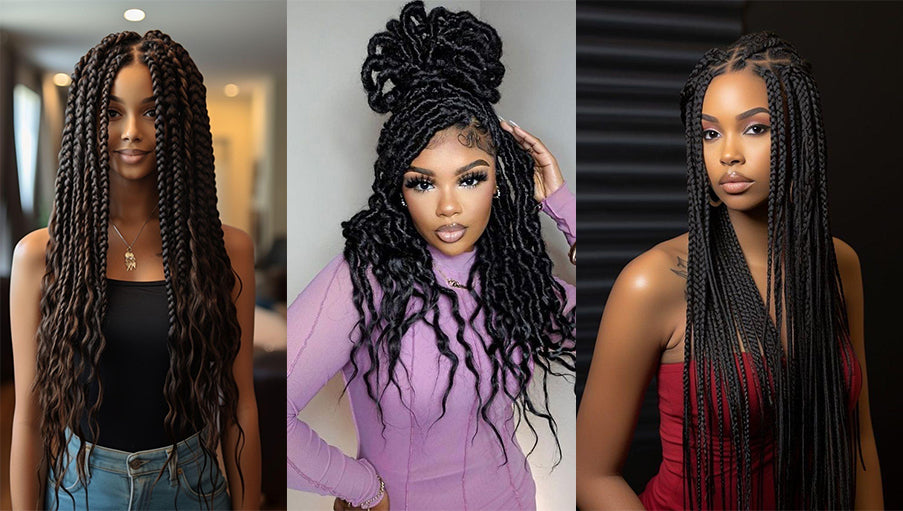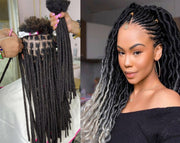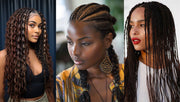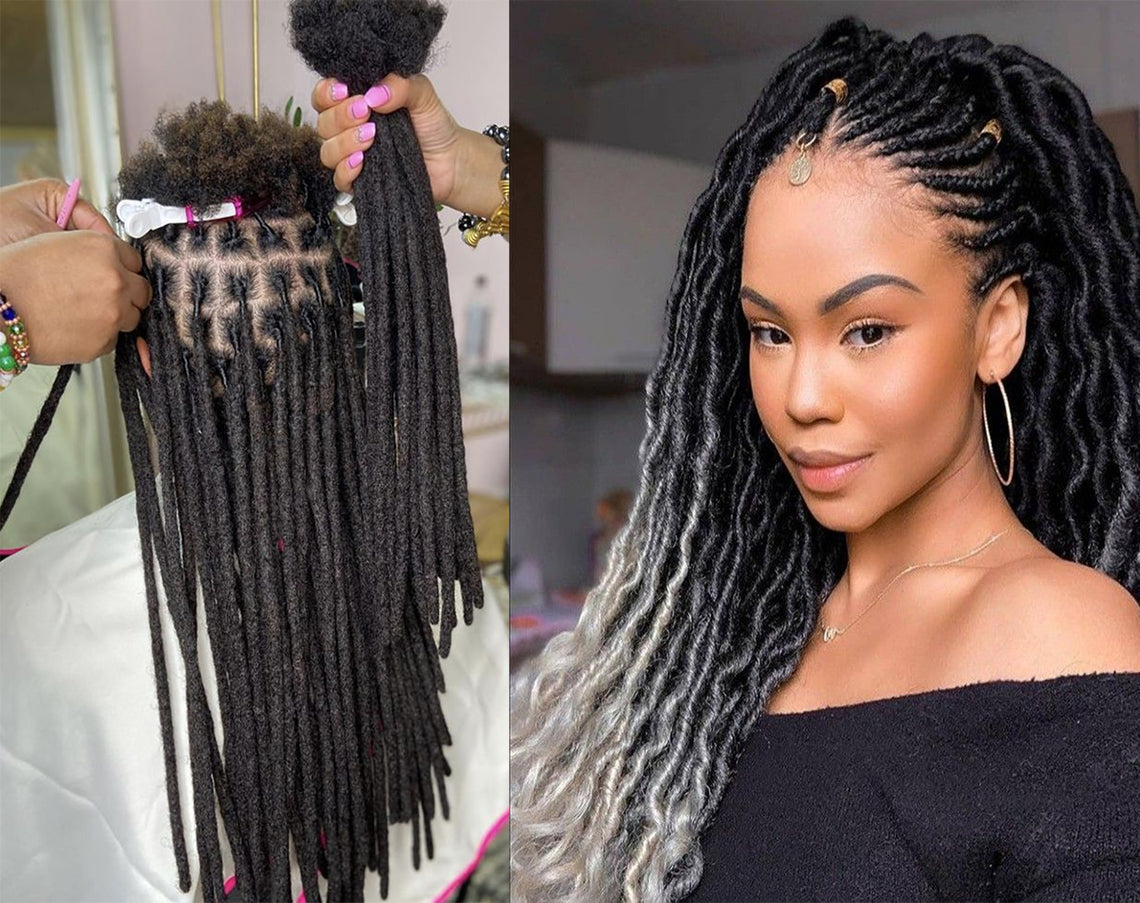A Complete Glossary of Terms for Loc and Braid Extensions

There are some loc and braid extension terms that are commonly used in salons.
Sometimes, it is impossible to get your hair done without using these words or phrases.
For instance, if you walk into a salon and tell one or two stylists that you want to install faux locs or knotless braids, they will immediately know what hairstyles you are referring to.
This way, you don’t need to describe too much or show a picture before you get your hair done.
This article covers a glossary of terms for loc and braids extensions that will help you easily achieve the hair expert status and navigate the world of hair extensions.
Read on and improve your “hairvocabulary”.
Types of Hair Extensions
Queens who slay with looks sometimes love to add some length to their hair.
You can achieve this length with hair extensions; the most common types are wig, loc and braid extensions. For the purpose of this article, we will be learning terms for just the last two.
Loc Extensions

Locs will always remain a trendy hairstyle for black women.
These extensions are a replica of dreadlocks, which is a natural way of locking your kinky hair into huge or small patterned twisted strands.
Even celebrities like Rihanna have been seen occasionally wearing loc extensions.
Braid Extensions

Braids are cute, however, when you add some length to your natural hair with extensions, you can go from looking basic to amazing.
Braids extensions can either be in human or synthetic hair. Both are great and you can pick any depending on your taste and preference.
20 Glossary of Terms for Loc and Braid Extensions
Glossary of Terms for Loc Extensions
Here are some terms you should get familiar with if you plan to install loc extensions:
1. Retightening
Retightening simply means that you have new growth that you want to secure to your locs.
2. River locs
River locs are loc extensions with a curly pattern. Unlike normal straight locs, they are wavy and have curls attached to them.
They may look like boho braids except that they are locs.
3. Sisterlocs
Have you ever seen tiny locks that may resemble twists?
These are sisterlocs— they are gorgeous micro-locs are soft and this makes them easier to style than thick locs, which are typically stiffer.

4. Interlocking
This is a way to secure new growth tightly to your locs by interlocking it. This way, you intertwine the loc extension to new growths so your hair can appear neater.
5. Gypsy locs:
River locs and gypsy locs look alike, but the difference is that the former always has curls attached to them. So gypsy locs are just wavy locs with no curls on them.
Most of the time, they are installed using the crochet method.
6. Latch hook method:
Like interlocking, the latch hook method is another way to retighten your locs.
So, instead of taking down your extensions when there’s new growth, your stylist will use a latch hook to retighten your hair.
7. Medium Locs
Medium locs are loc extensions that are in between micro-locs and big locs. They measure about 1 cm in width and often look like straws.
8. Faux locs

The simple meaning of faux locs is “false locs.” They are extensions that people without dreadlocks can use whenever they feel like wearing locs.
9. Jumbo Faux locs
These are very big loc extensions. They can be light or heavy depending on the texture or material of the extension.
10. Butterfly locs
Locs that have a detailed and deliberate roughness around them are called butterfly locs.
They can be achieved by installing premade ones with a crochet pin or by wrapping kinky extensions using a technique that creates roughness around tiny braids.
10 Glossary of Terms for Braid Extensions
1. Braid Pattern
Patterns are the foundation for any braided hairstyle. Before your stylist starts braiding, your hair will be divided into sections that will make your hairstyle tidy and organized.
A perfect braid pattern ensures the extensions blend seamlessly into your natural hair.
2. Kanekalon
This is a unique type of synthetic extension used for making braids. It is a popular choice because it’s affordable, versatile, heat resistant and, most importantly, it comes in various colors.
3. Cornrows

Cornrows are some of the oldest and most common weaving methods. Unlike braids, which are plaited in singular sections, your hair is parted from your hairline down to the back for cornrows.
After, the separated portion is braided using three strands consistently woven in a downward motion.
4. Crochet Braids

Ladies who love easy maintenance and fast hairstyles typically go for the crochet method.
style involves attaching braid extensions to your natural hair using a crochet needle. Some may prefer this method because of the fast installation process.
5. Box Braids

Box braids are the most trendy form of braids. They are made by partitioning the hair into well-detailed braids arranged in boxes.
They always have organized patterns and are the most common kind of braids.
6. Knotless Braids
These are braids that are made with extensions in such a way that people will be unable to see the knot that attaches the extension to our hair.
This way, the braids look like they are our natural hair because the connecting point is invisible. Box braids can either be knotless or knotted.
7. Boho Braids

Braids with curls attached to them are generally known. So, while your stylist braids your hair, they can attach either synthetic or human hair curls to create this stunning look.
8. Goddess Braids
Goddess braids are the same as Boho braids. However, some people may associate Goddess braids to tiny to medium braids that have curls around them.
9. Synthetic braid extensions
These are made from fiber materials such as nylon, polyester, or acrylic. These extensions are generally more affordable, and they come in various colors and textures.
10. Human Hair Extensions
Extensions made from people’s real are human hair extensions. These can be wavy, curly, or straight, and usually, they are of great quality and texture.
Conclusion
With the terms defined in this glossary, you can describe almost any hairstyle or extension you need to your hair vendor.
However, if you can’t find the right words to tell your hair vendor about the extensions you want to purchase, send a picture instead and pay attention to the phrase or word they use to describe it.
To learn more names of braid and loc extensions, check our website to see the product name for our hair.







